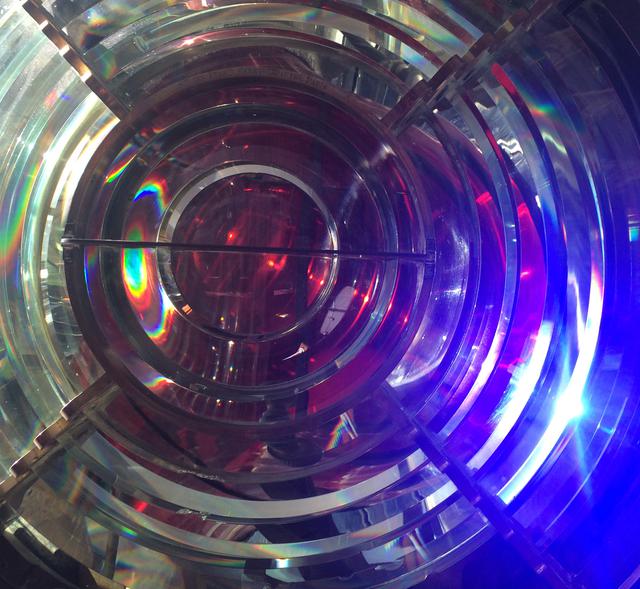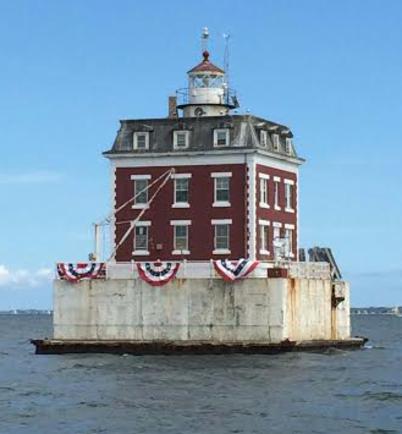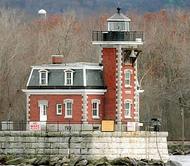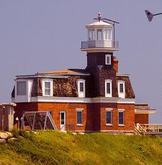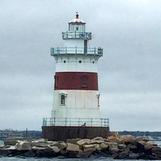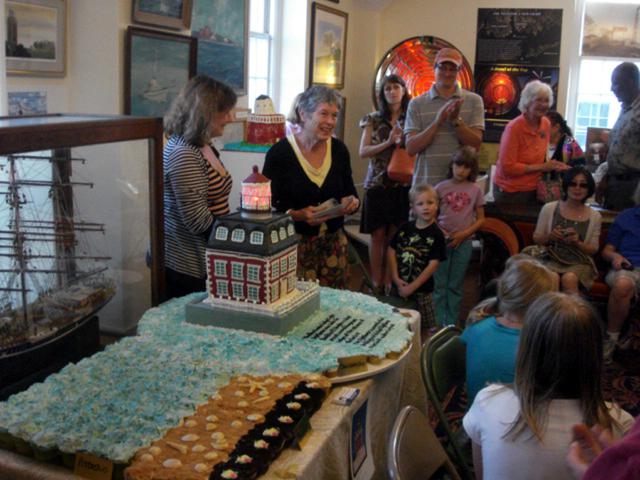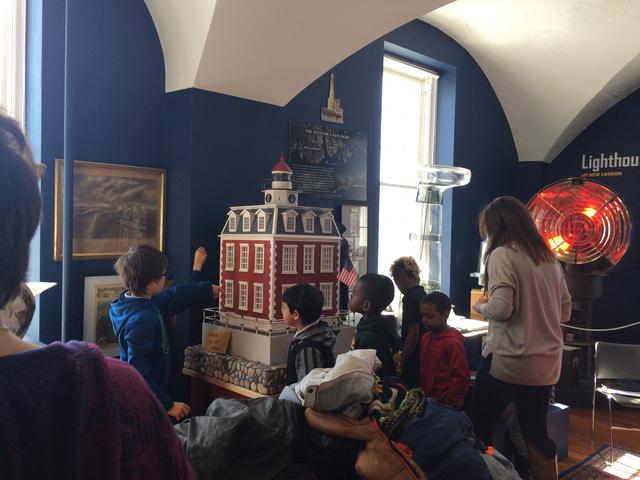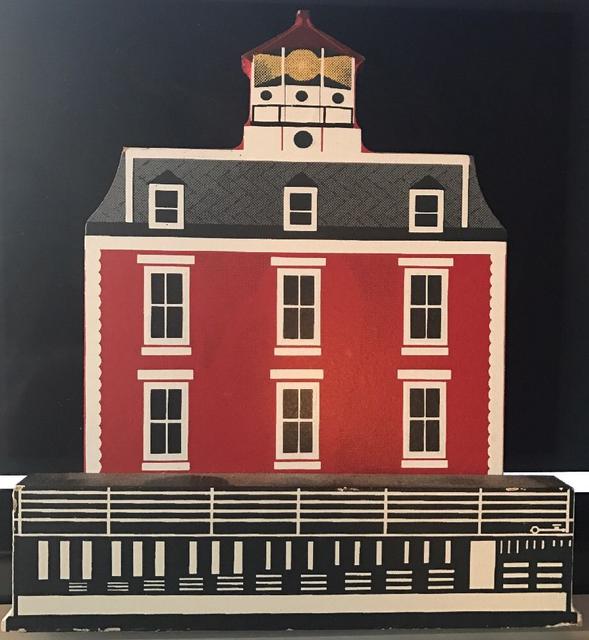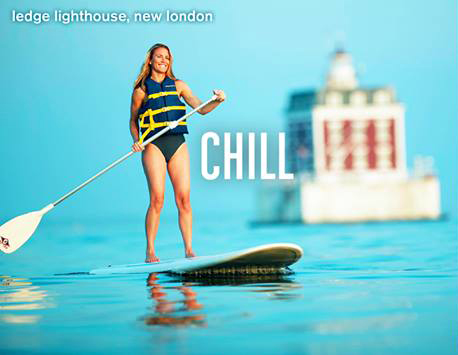Location: Thames River, New London Harbor, Connecticut
Station established: 1909, Automated: 1978
Focal height 58 ft.
Owned: New London Maritime Society, 2015.
The light's original 4th order clam-shell Fresnel lens, left, and original fog horn can be seen at the Custom House Maritime Museum.
For some time it had been felt that an additional lighthouse was needed between Race Rock and New London Harbor Lights to mark the dangerous Southwest Ledge that ran through New London Harbor. Proposed in the mid 19th-c, first lit in 1909, New London Ledge Lighthouse is a distinctive brick structure, with a French mansard roof.
According to local legend, when discussion of
and lobbied for something more traditional. (Nearby Latimer Reef Light, built in 1884, left above, is such a 'spark plug' light.) Ledge Light's design draws upon elements from Hudson River precursors like the Athens Lighhouse, below right, and even nearby North Dumpling Light, below left, each of these built in the 1860s.
(The following history is adapted from Lighthouse Friends): After decades more of inaction, in 1904 Congress approved an act appropriating $60,000 'for establishing a light and fog-signal at or near Black Ledge' The Lighthouse Board then moved the light's position about one quarter mile to the west to Southwest Ledge, as placing the light there would leave the deep channel to the west of the light - between New London Harbor and the opening of Long Island Sound to the Atlantic at Race Rock - free of obstructions. In 1907 Congress authorized the Board to go forward with the new light, provided the total cost did not exceed $115,000.
A contract was awarded to New London’s T.A Scott Company, which had masterfully constructed Race Rock Light some decades earlier. To provide the foundation for New London Ledge Lighthouse, Scott's workers constructed a timber crib made of southern yellow pine and held together with nine tons of iron and steel. Four tugboats towed the crib from Groton to Southwest Ledge, a short journey that took eight hours on August 18, 1908, and the wooden crib was then filled with concrete, gravel, and rip-rap to secure it in place in twenty-eight feet of water. The Lighthouse Bureau published the following description of the work in 1912:
The structure consists of a timber crib 52 feet square and 31 feet high filled with concrete next to its outer face and the interior filled with riprap and gravel, with a deposit of riprap on the outside 10 feet deep next to the crib and 82 feet square. The top of the crib extends 3 feet above mean low water and is capped inside the upper timbers with a layer of concrete 3 feet thick. This layer supports a concrete pier 50 feet square to a height of 18 feet above low water, the pier being provided in the interior with a cellar. The pier in turn supports a 3-story brick dwelling about 32 feet square and 34 feet 6 inches high, with mansard roof, from the top of which projects an octagonal brick watch room forming the base for a fourth-order, cylindrical, helical bar, cast-iron lantern, whose focal plane is 43 feet above the top of the pier.
The
work on the superstructure was sublet to the New London firm of
Hamilton R. Douglas, and the total cost of the lighthouse came to
$93,968.96.
The cellar in the upper portion of the concrete pier contained coal and oil rooms, a cistern, and a fog-signal engine room. A kitchen, sitting room, workroom, and bedroom were located in the first story of the lighthouse, while the second level had had four bedrooms. The third story was divided into three rooms, one of which contained the fog-signal apparatus.
The lighthouse was placed in operation on November 10, 1909, with the station’s fourth-order Fresnel lens, crafted in Paris by Henry-Lepaute, repeating the distinctive signature of three white flashes followed by one red flash every thirty seconds. In addition to the pulsating light, the station’s first-class, six-inch air siren also sounded a three-second blast every twenty seconds as needed. (The original fourth order Fresnel lens was removed and is now on display in the Custom House Maritime Museum.)
New London Ledge Light was originally called the Southeast Ledge light, but it was felt this could be confused with another lighthouse in New Haven, the Southwest Ledge Light. In 1910 the lighthouse was renamed to New London Ledge Light.
The United States Coast Guard took over in 1939 upon its merger with the Lighthouse Service and the light was automated in 1987.
New London Ledge was the last remaining manned lighthouse on Long Island Sound when it was finally destaffed in 1987. The automation process began in 1984, when the Fresnel lens was dismantled and removed from the lantern room and replaced by a modern beacon.
During its final years of manned operation, a four-man Coast Guard crew was typically on duty for tours of eighteen months at a time. Each crew member stood guard for a daily twelve-hour watch, during which his duties included monitoring the light, transmitting weather information to ships and shore, and performing maintenance on the station. Every few weeks, the crew received six days of shore leave. Life on the remote station must have been less than exciting for some of the young crew members – the final day of manned operation shows a log entry reading, “Rock of slow torture. Ernie’s domain. Hell on earth – may New London Ledge’s light shine on forever because I’m through. I will watch it from afar while drinking a brew.”
New London Ledge is locally famous for the ghost legend of an early keeper, nicknamed "Ernie," who allegedly haunts the lighthouse. The Coast Guard crew on duty at the lighthouse, not automated until 1987, reported unexplained knockings taking place at night, as well as doors opening and closing repeatedly, the television turning on and off by itself sporadically, and the unexplained removal of sheets from beds. Of course, Coasties are famous for playing practical jokes...and that's what this was!
In the crew's log, on the last night before the automated light system was installed, the unknown author, a Coast Guard officer, wrote the following: "Rock of slow torture. Ernie's domain. Hell on earth – may New London Ledge’s light shine on forever because I’m through. I will watch it from afar while drinking a brew."
The USCG still maintains and owns the lighthouse lamp and lantern. The Ledge Light Foundation formed to continue maintenance of the structure once the USCG automated the Light. The New London Maritime Society (NLMS) took ownership of the lighthouse in 2015 -- all three groups now work together at Ledge Light. Tours and charter visits to the lighthouse may be arranged through NLMS.
~ In 1990 the light was added to the National Register of Historic Places.
~ In 2011, NLMS began our annual Sentinels on the Sound series of lighthouse summer events. In 2011, The Cake Lady's rendition of Ledge Light won our Lighthouse Cake Competition.
~ In 2015, New London Maritime Society took ownership of Ledge Light through the US Lighthouse Preservation Act of 2000.
~ In 2016, NLMS began working with all LIS lighthouses to create a cooperative network for preservation, history and tourism.
~ in 2024, the LLF oversaw replacement of one rusted beam in the north facade -- a $250,000 project.
~ in July 2025, volunteers cleaned the lighthouse and prepared for the first public Ledge Light tours in two years!
Meanwhile, at the Custom House Maritime Museum we teach about Ledge and our area lighthouses every day! ≡
Tours to Ledge Light are offered every summer, from June through early September. Please check this website's home page for updates.
this new lighthouse came up, two prominent shoreline residents -- Mr. Platt in Groton and Mr. Harkness in Waterford -- made it clear they did not want to have to look out at the current 'Spark Plug' style then being built
To see a collections of Ledge Light toys & models, like the one above showing calibrations for submarines, visit the Custom House Maritime Museum. Ledge Lighthouse was featured in Connecticut tourism ads in 2015, above right..
Lighthouse Keepers, from USLHS
Wilford B. Petty Principal Lighthouse Keeper (1909-1910)
George E. Hansen Principal Lighthouse Keeper (1910-at least 1917)
Earl G. Merry Principal Lighthouse Keeper (1918-at least 1921)
Howard B. Beebe Principal Lighthouse Keeper (1926-1938)
Leonard Fuller Principal Lighthouse Keeper (1940- )
Michael Scanlan Principal Lighthouse Keeper (1943-1949)
William Clark Principal Lighthouse Keeper (1954-1959)
Israel H. Southworth Principal Lighthouse Keeper (at least 1925- )
Augustus D. Bennett 1st Assistant Lighthouse Keeper( -1916)
Allen H. Harris 1st Assistant Lighthouse Keeper (1909-1910)
Joseph A. Curran 1st Assistant Lighthouse Keeper (1910-1910)
Frank H. Card 1st Assistant Lighthouse Keeper (1910-1910)
John E. Miller 1st Assistant Lighthouse Keeper (1910-1911)
Irvin C. Larkin 1st Assistant Lighthouse Keeper (1911-1911)
William S. Parks 1st Assistant Lighthouse Keeper (1911-at least 1913)
Edward Grime 1st Assistant Lighthouse Keeper (1914-1914)
Earl G. Merry 1st Assistant Lighthouse Keeper (1915- )
Homer A. Waterman 1st Assistant Lighthouse Keeper (1918- )
Frank Hassell 1st Assistant Lighthouse Keeper (1918-at least 1919)
Howard B. Beebe 1st Assistant Lighthouse Keeper (1926-1926)
Archie De Mille 1st Assistant Lighthouse Keeper (1938-1939)
Earl G. Merry 1st Assistant Lighthouse Keeper (at least 1917- )
Elwood L. Butler 1st Assistant Lighthouse Keeper (at least 1921- )
Robert H. Lyons 1st Assistant Lighthouse Keeper (at least 1925- )
Daniel A. Sullivan 1st Assistant Lighthouse Keeper (at least 1940- )
David Griffiths 2nd Assistant Lighthouse Keeper( -1917)
George Anestaseada 2nd Assistant Lighthouse Keeper (1909-1909)
Frank H. Card 2nd Assistant Lighthouse Keeper (1910-1910)
Joseph A. Curran 2nd Assistant Lighthouse Keeper (1910-1910)
John H. Boldt 2nd Assistant Lighthouse Keeper (1910-1910)
John E. Miller 2nd Assistant Lighthouse Keeper (1910-1910)
J. W. Lee 2nd Assistant Lighthouse Keeper (1910-1911)
A. A. Brownell 2nd Assistant Lighthouse Keeper (1911-1911)
John Martinolish 2nd Assistant Lighthouse Keeper (1911-1911)
William F. Rhodes 2nd Assistant Lighthouse Keeper (1911-1912)
Louis B. Waterman 2nd Assistant Lighthouse Keeper (1912-1914)
Charles E. Minkler 2nd Assistant Lighthouse Keeper (1914- )
John N. Bennett 2nd Assistant Lighthouse Keeper (1915- )
Augustus D. Bennett 2nd Assistant Lighthouse Keeper (1915- )
Thomas Garrity 2nd Assistant Lighthouse Keeper (1915- )
Walter P. Dwelley 2nd Assistant Lighthouse Keeper (1915- )
Walter E. Bohn 2nd Assistant Lighthouse Keeper (1916- )
Delbert W. Waterman 2nd Assistant Lighthouse Keeper (1919- )
Howard B. Beebe 2nd Assistant Lighthouse Keeper (1926-1926)
Louis S. Poutray 2nd Assistant Lighthouse Keeper (1926-at least 1928)
Ernest F. Witty 2nd Assistant Lighthouse Keeper (1931-1934)
Ernest Metiver 2nd Assistant Lighthouse Keeper (1934-1937)
Archie De Mille 2nd Assistant Lighthouse Keeper (1937-1938)
Arthur Pynn 2nd Assistant Lighthouse Keeper (1938-1941)
George E. Sheffield 2nd Assistant Lighthouse Keeper (1941-1942)
William F. Crowell 2nd Assistant Lighthouse Keeper (1943-1943)
Grover C. Brown 2nd Assistant Lighthouse Keeper (at least 1921- )
Gorton S. Dedrick 2nd Assistant Lighthouse Keeper (at least 1925- )
Joseph D. Meade 2nd Assistant Lighthouse Keeper (at least 1929-at least 1930)

